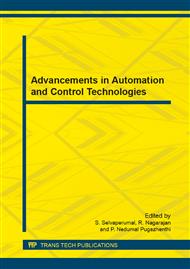[1]
T. Van Cutsem and C. Vournas, Voltage Stability of Electric Power Systems. Norwell, MA: Kluwer, (1998).
Google Scholar
[2]
C. W. Taylor, Power System Voltage Stability. New York: McGraw-Hill Education, (1994).
Google Scholar
[3]
P. Kundur, Power System Stability and Control. New York: McGraw- Hill Education, (1994).
Google Scholar
[4]
Chung, C.Y., Chung, T.S., Yu, C.W., and Lin, X.J.: Cost-based reactive power pricing with voltage security consideration in restructured power systems, Int. J. Electr. Power Syst. Res., 2004, 70, (2), p.85–91.
DOI: 10.1016/j.epsr.2003.11.002
Google Scholar
[5]
David, A.K., and Fang, R.S.: Security-based rescheduling of transactions in a deregulated power system, IEE Proc., Gener. Transm. Distrib., 1999, 146, (1), p.13–18.
DOI: 10.1049/ip-gtd:19990073
Google Scholar
[6]
V. Ajjarapu and B. Lee, Bibliography on voltage stability, IEEE Trans. Power Syst., Feb. 1998, vol. 13, no. 1, p.115–125.
DOI: 10.1109/59.651622
Google Scholar
[7]
Voltage Stability Assessment: Concepts, Practices and Tools, IEEE Power Engg Society, (2002).
Google Scholar
[8]
C. A. Canizares and F. L. Alvarado, Point of collapse and continuation methods for large ac/dc systems, IEEE Trans. Power Syst., Feb. 1993, vol. 8, no. 1, pp.1-8.
DOI: 10.1109/59.221241
Google Scholar
[9]
V. Ajjarapu and C. Christy, The continuation power flow: A tool for steady state voltage stability analysis, IEEE Trans. Power Syst., Feb. 1992, vol. 7, no. 1, p.416–423.
DOI: 10.1109/59.141737
Google Scholar
[10]
H. -D. Chiang, A. J. Flueck, K. S. Shah, and N. Balu, CPFLOW: A practical tool for tracing power system steady-state stationary behaviour due to load and generation variations, IEEE Trans. Power Syst., May 1995, vol. 10, no. 2, p.623– 634.
DOI: 10.1109/59.387897
Google Scholar
[11]
B. Jeyasurya, Artificial Neural Networks for on-line voltage Stability assessment, IEEE PES Summer Meeting, 2000, July 2000, Vol. 4, p.2014-(2018).
DOI: 10.1109/pess.2000.866956
Google Scholar
[12]
Bansilal, D. Thukaram and K. H. Kashyap, Artificial neural Network application to power system voltage stability improvement, Conference on convergent technologies for Asia-Pacific region, TENCON 2003, Oct. 2003, Vol. 1, 15-17, pp.53-57.
DOI: 10.1109/tencon.2003.1273214
Google Scholar
[13]
A. A. El-Keib and X. Ma, Application of artificial neural Networks in voltage stability assessment, IEEE Trans on PowerSystems, November 1995, Vol. 10, No. 4, pp.1890-1896.
DOI: 10.1109/59.476054
Google Scholar
[14]
V. R. Dinavahi and S. C. Srivastava, ANN based voltage stability margin prediction, in Proc. IEEE Power Eng. Soc. Summer Meeting, Jul. 2001, vol. 2, p.1275–1280.
DOI: 10.1109/pess.2001.970256
Google Scholar
[15]
S. Kamalasadan, A. K. Srivastava, and D. Thukaram, Novel Algorithm for online voltage stability assessment based on feed forward neural network, in Proc. IEEE Power Eng. Soc. General Meeting, Jun. 18–22, (2006).
DOI: 10.1109/pes.2006.1709621
Google Scholar
[16]
Debbie Q. Zhou and Athula D. Rajapakse, Online Monitoring of Voltage Stability Margin Using an Artificial Neural Network, IEEE Transactions On Power Systems, August 2010, Vol. 25, No. 3, pp.1566-1574.
DOI: 10.1109/tpwrs.2009.2038059
Google Scholar
[17]
P. Devijver and J. Kitler, Pattern Recognition: A Statistical Approach. Englewood Cliffs, NJ: Prentice-Hall, (1982).
Google Scholar
[18]
H. Demuth, M. Beale, and M. Hagan, Neural Network Toolbox User's Guide. Natick, MA: Math Works, Oct. (2008).
Google Scholar
[19]
B. Jayasekara and U. D. Annakkage, Derivation of an accurate polynomial representation of the transient stability boundary, IEEE Trans. Power Syst., Nov. 2006, vol. 21, no. 4, p.1856–1863.
DOI: 10.1109/tpwrs.2006.881111
Google Scholar


